D A T A
![]()
1873
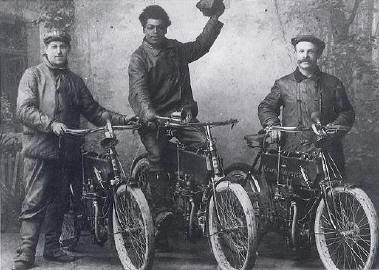 NSU was established by Christian Schmidt and Heinrich Stoll in the year 1873 near the river Donau in the German town Riedlingen. After seven years of production the company was moved to
Neckarsulm. In it’s first twenty years NSU produced knitting machines.
NSU was established by Christian Schmidt and Heinrich Stoll in the year 1873 near the river Donau in the German town Riedlingen. After seven years of production the company was moved to
Neckarsulm. In it’s first twenty years NSU produced knitting machines.
Starting in 1886 the ‘Neckarsulmer Strickmaschinenfabrik’ also produced bicycles. From that moment on, bicycles would play a major role throughout the existence of NSU. Production of motorcycles started in 1901, followed five years later with the first automobile. The production of automobiles was stopped in 1929, so the company could fully concentrate on the bicycles and motorcycles. It wasn’t until 1958 before car manufacturing was restarted.
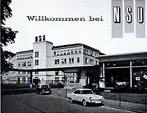 On 10 March 1969 Auto Union GmbH based in Ingolstadt merged with NSU Motorenwerke AG at Neckarsulm. The new company was to be called Audi NSU Auto Union AG with
its headquarters at Neckarsulm.
On 10 March 1969 Auto Union GmbH based in Ingolstadt merged with NSU Motorenwerke AG at Neckarsulm. The new company was to be called Audi NSU Auto Union AG with
its headquarters at Neckarsulm.
PLANS Early sixties, when NSU was only producing small cars, they decided to built a big, exclusive motorcar to emphasize the advantages of the newly developed Wankel engine. The NSU Wankel Spider was merely a cabriolet version of the NSU Sportprinz. NSU had quite a reputation for building exceptional cars, be it for technical or for styling reasons. The NSU Ro 80 can be regarded as the final outcome of the development, which took place within NSU. You even could say, that the Ro 80 was a car built by engineers for engineers. On these pages you can find some highlights of the development of the Ro 80.The Ro 80 is the companies’ evidence for the slogan "Vorsprung durch Technik" (A leap because of technology or Advance thanks to Engineering).
START
18 augustus 1961
 It was in the castle "Wald-und-Schlosshotel" at Friedrichsruhe
(yes, it’s still there…), about 30 kilometres to the east of Neckarsulm that the final outlines of the Ro 80 were embodied by Ewald Praxl (Project-leader), Walter Froede (Research), Sussner (Production) and Strobel (Construction). You could say that it was here where the NSU Ro 80 was born!
It was in the castle "Wald-und-Schlosshotel" at Friedrichsruhe
(yes, it’s still there…), about 30 kilometres to the east of Neckarsulm that the final outlines of the Ro 80 were embodied by Ewald Praxl (Project-leader), Walter Froede (Research), Sussner (Production) and Strobel (Construction). You could say that it was here where the NSU Ro 80 was born!
Some of the points they took in consideration to place the Ro 80:
Middle-class, like Ford’s 12M, boot just like it, sporty, two doors, possibly sliding doors. Two-rotor Wankel engine placed in front, rear-driven, gearbox with lock-differential.
Air-suspension, disc brakes front and rear and hydraulic gearbox. They certainly went for it - we now know that quite something else was achieved…
5. April 1963
The project for the Ro 80
was named T80 (Typ 80). Claus Luthe is chief-designer, assisted by Josef Erlewein (body construction) and Otto Erlewein -not related- (interior). Because the design was complete new, the three men were free to use their imagination. And as it was expected that funds from the Wankel licensees would start to come in, it was allowed to build
an exclusive car.Weight should be approx. 800 kilo, engine 80 hp, fuel consumption of 8 litres to 100 kilometres, price around 8.000 German Marks. The figure 8 can also be found in the shape of the trochoïde - the rotor housing. About 80 people were involved with the development. Nowadays hundreds if not thousands of people are involved
with the development of a new car…
The NSU Wankel Spider was the first production car in the world equipped with a Wankel engine. This was a single-rotor unit, where as the Ro 80 was destined to receive a twin rotor unit
6. Mei 1963
Model 1:5 - begin.
Luthe is 30 years of age and since 1956 working with NSU. He knew the Ro 80 was a thirsty engine, so it was evident that the body should be well shaped. Streamline, aerodynamics and Cw-values were hardly points of issue those days; something revolutionary had to be built!
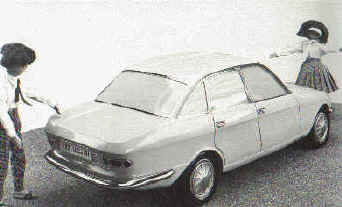
2. Augustus 1963
Four years before production the basic shape is final. The car’s wedge-shape (low front - high rear) was used for the very first time; other manufacturers were to follow years later. An enormous amount of windscreen was planned, it even had a window behind the C-column, and was already called the hothouse. Perfect vision was assured with this though. Because of the to the front expiring engine bonnet the car would be stable with high speeds. Originally the roof had two profile lines, but these were cancelled so it would be easier to fit a sunroof. The rear doors followed the wheel-edge, later these became vertical. The headlights of this 1:5 model may look familiar: think of the Citroën SM. Bear in mind that that car was developed years later, so it’s obvious that Citroën ‘borrowed’ this design…
16. september 1963
With the help of only six people Luthe made the first prototype in scale 1:1, neatly finished, sprayed and polished as if it was a showroom model. Already with the correct front, bumpers still a bit rough, wheel arches too rectangular. The bonnet closes right to the windshield. This wooden model has an internal steel construction in order to have a look at the interior.
The interior itself was designed in May 1964.
6. Mei 1964
Model 1:1 Finished interior.
First cars made for testing. Prototype’s: 16 and pre-production: 18. (Made between 7 April 1966 and April 1967). Engine bay painted black. Bumpers blind-welded. Clothe headlining. Wood imitation on dashboard. Wankel (Rotary) sign on steering wheel.
Wind tunnel testing
The aerodynamic proportions (Cw. 0.355) almost couldn’t be better; look at how neat the vanes behave with the bodywork. (picture left )
Modern details: the headlamp housings with integrated flashing lights. Beamers beneath the bumper mounted in the spoiler. Enormous glass area.
First pre-production car. Click to see the eldest known Ro 80 of German in existence today
10. Februari 1967
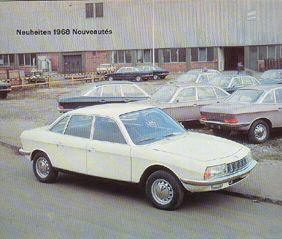 Regarding the name Typ 80 we must note that this name could not be used as Mercedes had a record car with that name. Because of the Rotary Club, Rotary 80 was also not an option. The name NSU Delphin was rejected because of its
similarity in name with Renaults Dauphine. Even Rota was rejected, as there was an Austrian engine construction company with that name. Finally NSU Ro 80 was chosen as type name.
Regarding the name Typ 80 we must note that this name could not be used as Mercedes had a record car with that name. Because of the Rotary Club, Rotary 80 was also not an option. The name NSU Delphin was rejected because of its
similarity in name with Renaults Dauphine. Even Rota was rejected, as there was an Austrian engine construction company with that name. Finally NSU Ro 80 was chosen as type name.
Remarks: most of the modifications were carried out after summer-holidays, and so the new model year started. This varied from year to year. Chassis numbers were not always issued at production sequence, but also on date of invoice. It’s therefore that a car with a high chassis number could have been produced earlier than one with a lower number.
Augustus 1967
Sept.
1967
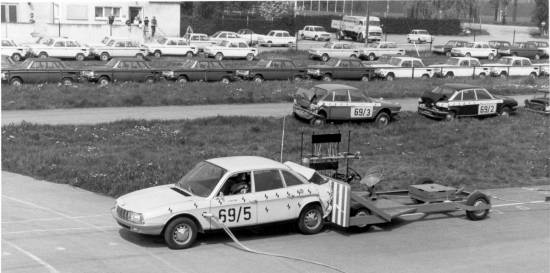
Several pre-production cars were used for crash tests. Do you want to see more of these? Click CRASHES .
The introduction of the NSU Ro 80 at the International Car Show at Frankfurt, Germany.

1968
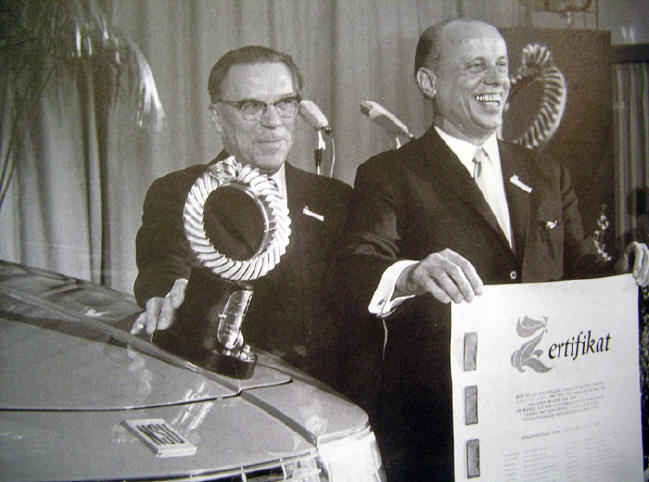
The Ro 80 becomes
“Car of the year” in 1967; see all the details in this special
on this site. The engine area is now in car-colour instead of black. Upholstery of the doors changed. Ventilation holes in thresholds. Some cars had silence-materials in the engine-area to deaden out engine sound, more or less the same as what was used at the underside of the car.
1969
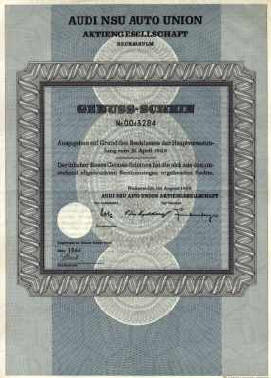 On March 10, 1967 Auto Union GmbH merged with NSU Motorenwerke AG (Neckarsulm). The newly formed company started life as per January 1, 1969 and was called Audi NSU Auto Union AG. This new company with its headquarters in Neckarsulm,
expanded production from day one. Because of the first oil-crises from 1973, production dropped from 400.000 cars to 330.000 in 1974.
On March 10, 1967 Auto Union GmbH merged with NSU Motorenwerke AG (Neckarsulm). The newly formed company started life as per January 1, 1969 and was called Audi NSU Auto Union AG. This new company with its headquarters in Neckarsulm,
expanded production from day one. Because of the first oil-crises from 1973, production dropped from 400.000 cars to 330.000 in 1974.
On the 1969 brochure at the left is explained why the Ro 80 is “Car of the year”. The name NSU Ro 80 still exists. Red plastic cooling fan instead of aluminium one.
Halogen beamers are optional.
Right: Audi
NSU Auto Union (Neckarsulm 1969) - Genuss-Schein begeben zur
Finanzierung des Wankelmotors
1970
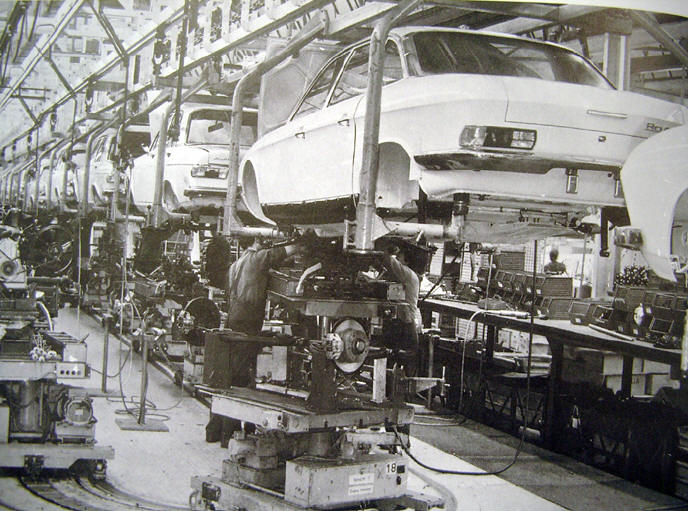
IMPROVEMENTS
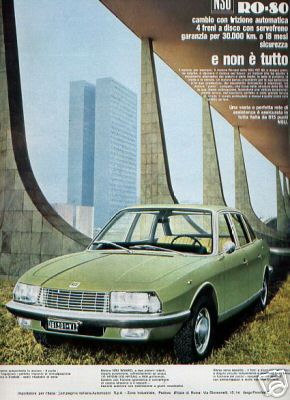 The so-called “Hasenmuhle” program was launched to test Wankel engines with short rides.
The so-called “Hasenmuhle” program was launched to test Wankel engines with short rides.
Cars were driven off and on from the factory to the small village Hasenmuhle, about a mile (1.500 meters) away. Here they were left for the engine to cool down again, and were then driven back to factory. It was found out that with the new Ferrotic seals wear one-fourth of that with the old seals. This gave a boost to engine reliability - it should now cope easily with 100.000 kilometres. Some 1.000 engines were tested by around 450 employees at the factory to achieve this result!
Only one spark plug per rotor, high-tension ignition, and seals made from Ferrotic (Titanium). Headlights modified; separate lenses for low- and high beam. Aluminium grille replaced with cheaper plastic one. Switches and control lights on dashboard now with clear pictograms to identify their function. Windshield wipers with interval.
Ignition box modified
1971
Down: a rare sample in German text of the theme's in a NSU/Audi press delivery from 1971.
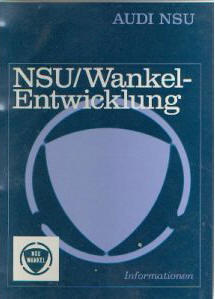 Inhaltsverzeichnis:
Entwicklungsgeschichte des
Kreiskolbenmotors
Inhaltsverzeichnis:
Entwicklungsgeschichte des
Kreiskolbenmotors
Prinzip der Arbeitsweise - Drehbuch des NSU/Wankel-Motos, Allgemeine Vorgeschichte - Auf neuem Kurs, Forschung und Praxis - Bootsmotoren - Jahresringe, Vorgeschichte des Kreiskolbenmotors, Geschichte des NSU/Wankel-Motors - Felix Wankels Lebenslauf
Gegenwart und Zukunft Serienentwicklung und Produktion - Abgasreinigung, Aktion "Saubere Luft" - Die Lister der Lizenznehmer NSU Ro 80 Technische Daten - Perspektiven und Details - Technik Fortschritt bei den Lizenznehmern
Forschung und Serie - Von Curtiss-Wright's "Big Boss" bis Graupners "Benjamnin" - Chronologie der Wankel-Entwicklung - Quellennachweis wichtiger Veröffentlichungen über den NSU/Wankel-Motor
1972
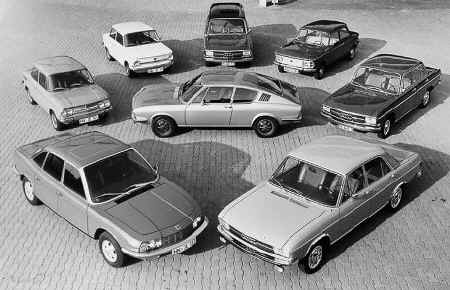 Front wheel mounting changed. Different shock absorbers, now aluminium.
Front wheel mounting changed. Different shock absorbers, now aluminium.
Automatic choke and new type of carburettor. Ignition box (8-connectors) now on rear panel of the engine compartment.
Picture with an overview of all models by Audi NSU in 1972.
1973
1974
August 1975
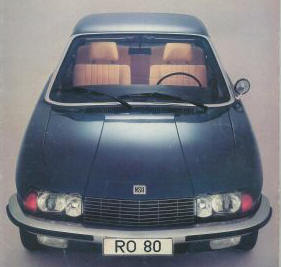
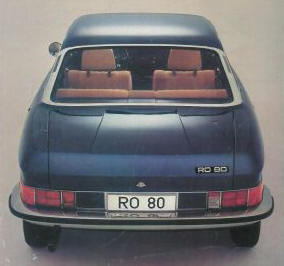
First and only major face-lift. (Bigger rear-lights, rubber strips on bumpers, Ro 80 badge at bonnet restyled, license plate now above bumper). By 1975 the car industry came back to ‘normal’ sales figures; this recovery was also visible at Audi sales.
1976
New bigger rear lights with built-in fog lamp; bumpers now with rubber strip. Bonnet lock changed. Ro 80 badge at rear modernised. License plate now above bumper. Exception: Switzerland/Italy: bumpers are divided in two separate units since model year 1976.
1977
THE FINAL ONE
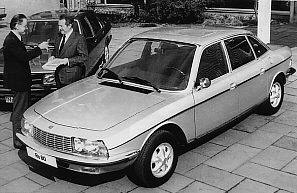 |
Audi director Dr Habbel delivers the keys of one of the last Ro 80's build - a silver metallic with rallystripes- to the German museum for technic in Munchen. |
19.04.1977: the final one
The final Ro 80 left the factory in April 1977. This meant, that after more than 100 years, the name NSU would cease to exist. After this date all cars leaving the factory in Neckarsulm bear the name Audi. At the picture left you see an image from
the latest brochure. Approximately 37.500 Ro 80’s were built.
Jan Hullegie owns one of the very last Ro 80’s made: a
marsred project car,
looking for a new owner. The very last Ro 80 is on exhibit in the Technology Museum in München, silver-grey with only 4 km’s on its odometer. This is one of the very very few original new cars that still exist today. I’ve been
there, on my back to inspect the underside of the car… It was clear to see that this underside had the same colour as the body - no Unterbodenschutz here!
NO NEW ENGINE?
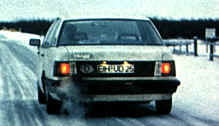 The new more powerful engine KKM 871 that was planned for the Ro 80 was tested in several Audi 100’s. On the site www.audi100-online.de
by Oliver Wischerath
you can find more information about this.
The new more powerful engine KKM 871 that was planned for the Ro 80 was tested in several Audi 100’s. On the site www.audi100-online.de
by Oliver Wischerath
you can find more information about this.
Quite a lot of info about the Ro 80 as the Webmaster is a great fan of ‘our’Ro 80!
It is even mentioned that some Audi 100 cars used the Ro 80 logo at the boot during test drives. Picture right
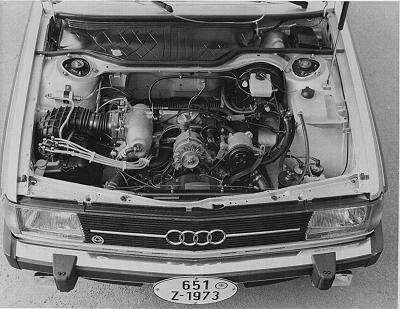
Audi 100 prototype with the famous
871 Wankelengine
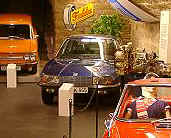 NSU MUSEUM NECKARSULM
NSU MUSEUM NECKARSULM
Not much specific Ro 80 information is found here: it’s the general NSU Museum, so all products are at display. It’s certainly worthwhile to visit this Museum in Neckarsulm. You could also visit the former NSU-factory at Audi. Neckarsulm
is rather a dull city; for more entertainment it’s better to drive on to Heidelberg.
THE BIBLE OF NSU Ro
80
This already rare and sought-after book by Dieter Korp is regarded as “The Bible” for Ro 80 admirers. Dieter Korp is a well-known
car-journalist, who published countless of articles about the Ro 80 and the Wankel engine in various German magazines, like Auto motor und sport. The Ro 80 book is only available in German, ISBN 3-613-01455-6, published by Motorbuch Verlag.
Also by Korp is the even more rare publication “Protokoll einer Erfindung”, a detailed review of the history of the Wankel engine, also published by Motorbuch Verlag, ISBN 3-87943-381-X. Buy one if you find one!
From: Marco Pignata - Italia pignama@tiscali.it
Dear Ro 80 drivers, there is an idea which is continuoausly flashing in my
head since years: translating Dieter Korp Ro 80 book from German into
English. Maybe that due to similarities with German language, Dutch Ro 80
fans do not need it, but the rest of the non-German-understanding fans in
the world do has no access to the precious infos contained in that.......I
am wearing out my own book just watching pictures and trying to understand
what is written there !!!!!!
The idea I launched years ago through the Italian NSU Club was to collect
money between fans in order to pay for a translation to Italian : this
proved unsuccessfull due to the low number of italian Ro 80 "supporters" at
that time. I think now it would be worth trying to propose the same idea
through this website to the many English readers ( I am thinking about
Ro80 fans worldwide): launching a survey asking if anybody would be ready
to spend some money to get the book translated, would enable us to count
how many people and consequently how many $$$$ would be collectable to
execute the translation to English version....then we could decide how to
do the job !! I would personally be ready to spend some money to get the
"bible" accessible to me !!!
I understand this is not easy to do and realize that other aspects should be
evaluated before (for example copyright rights) , but would like to hear
your comments on that or any better idea > > Ciao !
Marco M. Pignata e-mail: pignama@tiscali.it
Thanks>>>>>>>>ciao
Marco M. Pignata
1993
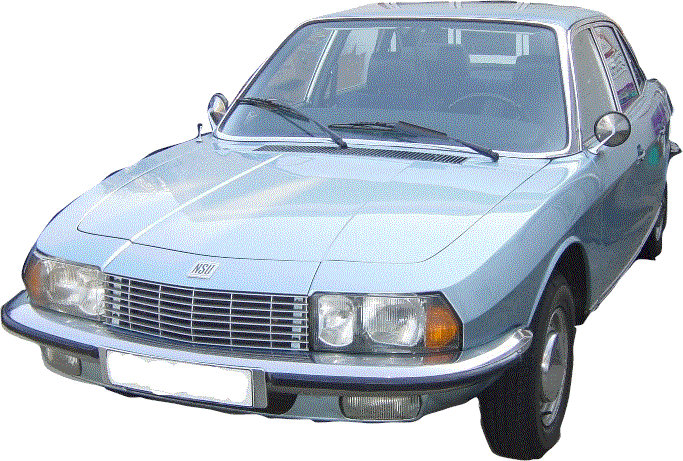 "Conceived in the 1930s, simplified and successfully tested in the 1950s, the darling of the automotive industry in the early 1970s, then all but abandoned before resurging for a brilliant run as a high-performance powerplant for Mazda, the Wankel rotary engine has long been an object of fascination
and more than a little mystery. A remarkably simple design (yet understood by few), it boasts compact size, light weight and nearly vibration-free operation.
"Conceived in the 1930s, simplified and successfully tested in the 1950s, the darling of the automotive industry in the early 1970s, then all but abandoned before resurging for a brilliant run as a high-performance powerplant for Mazda, the Wankel rotary engine has long been an object of fascination
and more than a little mystery. A remarkably simple design (yet understood by few), it boasts compact size, light weight and nearly vibration-free operation.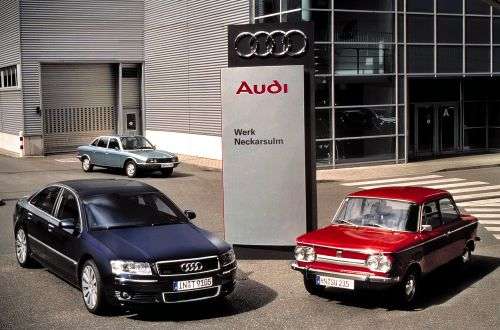 Audi plant
2005
Audi plant
2005